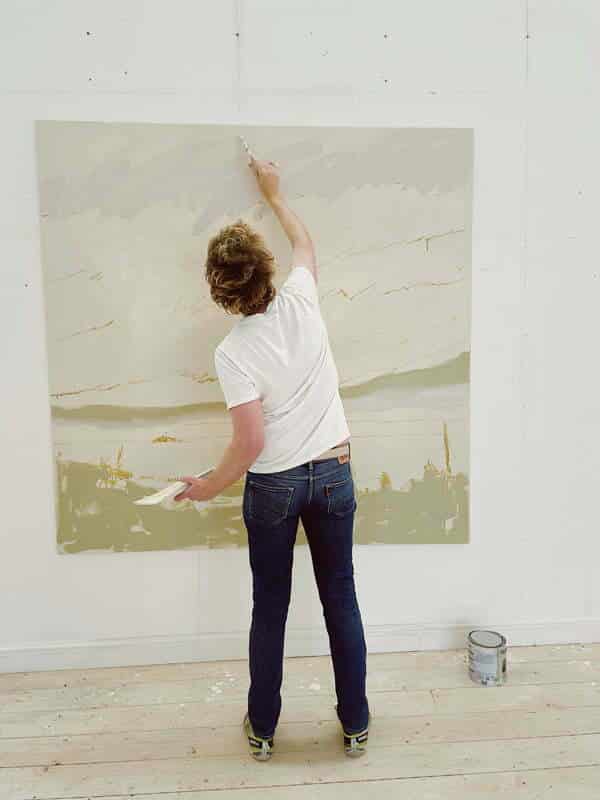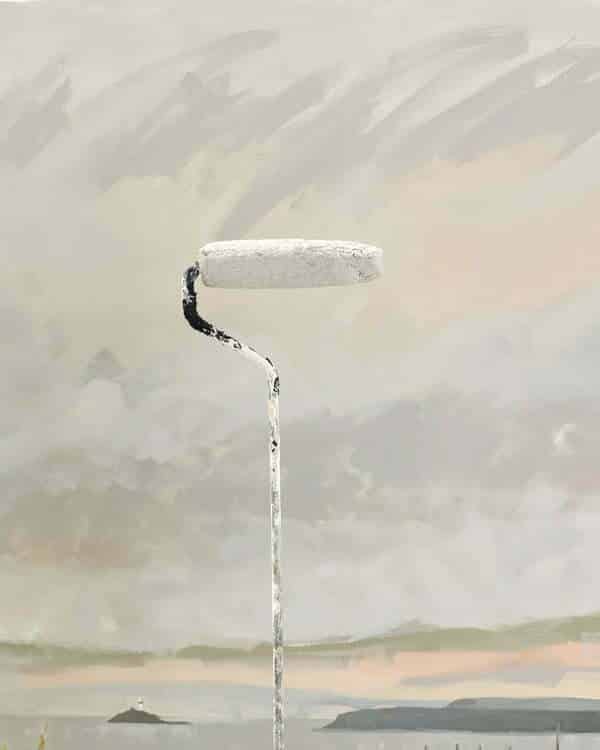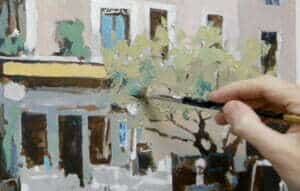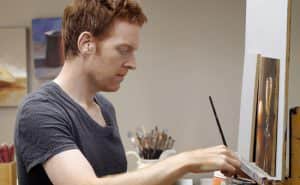
Painting large scale is not just a matter of having the right size canvas and paint. It’s also about adopting slightly different working methods and brushstrokes than when you work with a small canvas, and it’s one of the best ways to stretch your skills as a painter, even if you predominately paint small.
After months of renovation, I have recently regained the use of our new studio space. For the last 6 months, it had become the perfect place for storing multiple power tools and timber that needed acclimatising. It has been uplifting emptying the space of leftover building materials back to an empty room.
So last week with great relish, energy and anticipation, I propped up a large-scale 2m square canvas against a newly cleared wall and got to it.
I had a loose plan of the final image.
I’d sketched a pen and ink thumbnail of the view and had a palette of colours in mind but if I’m 100% honest I was super excited by the freedom of painting in a big space and seeing how the new studio felt.
Here are five things I learned.
#1. A little colour change is a big colour change.
Mixing the right colours for a large scale is not easy.
On smaller-scale pieces, your reference image is often close in size to the final piece, so you can translate the effect of the colour quite easily, but when you scale up an image everything becomes exaggerated.
As soon as you scale up the surface area that a colour covers, it has more of an intensity to it. The same colour ratio I would normally go for in a smaller piece looked more colourful once it was painted onto such a vast area.

#2. Scale up your brush to match your canvas size.
Just as you have to be aware of scaling down your colour choices and scaling up the volume of paint, you have to use larger tools to apply the paint too.
I rapidly went from a 1/2-inch brush to a 3-inch brush to a mini-roller!


I could have probably used a 9 or 12-inch roller for the scale of the marks I’d liked to make.
#3. Some parts of the process are quicker than you think, others seem to take ages.
You can cover a big area of the canvas relatively quickly, but when working with quick-drying paints like acrylics or household paints it’s harder to balance and adjust your hues.
Acrylics will dry much faster so you have less time for corrections, and on a larger scale, this can become frustrating with acrylics. I’ve found the best method to try and compensate for this is to do more pre-mixing of colours and use a stay-wet palette. This will enable you to concentrate on the painting and be able to go back and blend areas more easily.
Oils give you more time for corrections and tweaks to edges and you have that luxury of time to be able to step back from the painting, see what needs adjusting and then correct on the canvas before the paint dries.
To change a cloud on a small painting is one brushstroke, on this scale, it was more like half a tin of paint to cover up a mistake.
(I was using left-over household paint, there is a big colour shift in the drying process from wet to dry so it’s even harder to judge the values. This is an experimental piece for my own studio and is needless to say non-archival!)
#4. You need to scale your viewing space to match your painting
I noticed that values looked good when I was up close to the canvas, I could see a clear value step.
Because I was working in a new, much bigger space than I have ever previously, it gave me the opportunity to move a lot further back. When I walked back across the room the values merged into one to create a new shape I didn’t necessarily want or like. So I found I had to expand the value jumps slightly, so the painting ‘read’ as I wanted from a more extended viewing distance.
#5. I drank more tea and ate more biscuits
It’s way more physical. It’s quite freeing but you have to engage your whole arm to make a mark, which resulted in lots of breaks.
The secret to painting large scale?
I made every mistake that I teach students not to.
I got excited about being gestural and feeling like an artist. And it started off really fun! But when the drawing wasn’t working, and the sections I wanted to blend had dried too soon, it became harder.
The secret to successful spontaneity when working large scale is counterintuitive.
I should have taken my time and planned ahead better. I should have fully worked up a value map and then a full-colour poster study.
I found the canvas fell off the wall or moved from the props, I definitely need to invest in a better hanging system for large-scale works.
If you have never painted on such a large canvas before, try it out on smaller pieces first. Get a value map that works, and mix up more paint than you think you’ll need. Consider what type of paint you will use, how many colours, how much time you can devote to the work, and whether or not you have a large enough studio space to work in and view the piece from far enough back.
If you’d like to see these methods in action you might enjoy the Venice Seascape Course where I practice this.
It’s the course I should have watched before starting this painting but I really enjoyed the learning curve and will review, reconsider and rework parts of the painting over the coming weeks.





Thanks so much for your tips Will. It’s good to see what NOT to do as well as what TO do.
Hi Sarah,
Exactly! So glad you enjoyed it,
Cheers
Will
Thanks, Will. This was so interesting and packed with great tips!
Cheers Jennifer
Good morning Will, thank you very much for this tutorial and the many others that I have received though the years. I read them with relish. I read them, think about them, and refer back to them as I continue my journey learning about art and life. For example, years ago you had visited a place and shared your experience with Joaquin Sorolla’s paintings and the colors and scents and flavors of the locations/sunlight/weather/buildings/ plants were an important part of the painting and the story of the painting. This was very meaningful and I appreciate you sharing of these insights. Please continue with your conversation.
Thanks Richard what a lovely comment!
So pleased you’re enjoying the journey,
Will
…amazing … please make a large scale tutorial … I will be the first to join it
Cheers, Svend!
Loved all the points you made on painting on very large sized canvases…….have a friend w
Hi paints scenes and stuff on walls, she has helped with some hints.
That’s great Betty! Every perspective helps,
Cheers,
Will
You use house paint on a piece of fine art? Is this an acceptable practice in the art world?
Enjoy your new studio; where we paint is important.
Thanks.
Hey Marie,
I note in the article this is an experimental piece for my studio that will not be for sale and needless to say will be non-archival.
Other modern painters have sold paintings created with household paint for thousands, the real issues come for conservators down the line, or is the natural deterioration part of the art?
Cheers
Will
Thank you, Will. Fascinating see you painting on a large scale with household paints! Glad to hear your renovations are nearly finished. When will the update on the Art of Acrylics- Still life Painting Course be available? Can’t wait to get it!
Hi Nancy,
Thanks for your kind words, yes phase 1 of the renovation is looking great!
The Art of Acrylics remake became a split between the Floral Still life and the Modern Still Life Courses, good to know there’s room for more Old Master Style still-life classes.
Cheers
Will
Thanks for sharing, Will. It’s very instructive reading about your process, and reassuring to know that even an experienced and accomplished artist, as you are, still learns through trying things out and making mistakes. Judging from the video, you had fun and the painting looks great nonetheless!
My pleasure Martin, pleased you found it helpful.
Will
Once again you come out tops, Will. Not only are your lessons the best but you are courageous enough to reveal mistakes you’ve made and how you’ve fixed them.
Being transparent and humble as well as being a top artist highlights your value and that of your teaching.
I wish you all the best in your new Studio.
Regards,
Shirley Duncan
Thanks so much for your kind words Shirley, very much appreciated.
Will
That was a really enjoyable film. I loved the free use of household paints and brushes, and the story of the painting’s development. The subtle scrubby brush noises gave it an ASMRish quality which added to the fun. It’s great to see the studio get its first workout.
Thanks and best wishes.
Miles
Cheers Miles, glad you liked the paintbrush acoustics!
Hello again,
I just read your reply to a comment about the gradual deterioration of the materials being an intrinsic part of the work. I completely agree with this.
I use all manner of household paints, both oil and water based paints mixed with decorators’ caulk for body, pollyfiller type products and so on. I sometimes use cheap old gloss white paint that I know will yellow with age and layer it with white that I know will remain pure. You get all kinds of interesting crackling, fading, and interesting effects as the paint matures at different stages. Whether or not they will last for decades is another story.
Thanks again,
Miles
My pleasure Miles.
Great job Will! By making mistakes and learning something new keeps the mind fresh, nothing wrong with that.
Too right Mike.
Would you consider a course on a looser style of landscape painting as I want to become a little less literal and more abstract?
Good to know Chris that a looser abstract-based course would be of interest.
Will
Love looking over your shoulder as you progress your work. Very interesting Will.
Are you going to have your studio open to visitors?
Hey Pat, pleased you enjoyed the video. The studio isn’t an open studio, however, If you’re passing the door I’m nearly always free for a brew!
Wonderful! A new adventure thanks Will.
Actually I restarted my painting exploits on a very large canvas using domestic paints and brushes so I can relate. At that time I had space to spread out but as the painting space diminished so did the size of my canvases.
Happy days!
Great stuff Anita, glad you’re enjoying the new scale.
Thanks Will for this post. I loved your new workspace! My husband just build at wall easel–8 feet wide by 6 feet tall–and adapted some hanging mechanisms for me. I am SOOOOO looking forward to painting on my first large canvas–36″ x 36″–Your tips have given me some good grist to chew on.
One question: Did you mix standard acrylic artists paints with latex house paints? (I’ve done window murals, and I did on the glass.) Did you prep the canvas with an under painting–with gesso or ????
Sounds fabulous Linda. The canvas was prepped with gesso and a ground colour, and yes just mix acrylic with the house paints. This isn’t a piece for sale, but as a personal experimentation, so non-archival.
Cheers,
Will
I’m so with Svend – I’d totally take a ‘how to paint large’ tutorial by Will Kemp. Super yum.
Great to know Sonia.
Hi Will,
I had the opposite problem. For years I painted scenery for my school plays. I’m talking 12ft by 36ft backdrops. After I retired and realized I wanted to try “artistic “ painting, I was scared that I wasn’t going to be able to paint small. You have been a huge help in that regard. The other person who has been my virtual mentor is Roger Bansemer.
Thanks for all you do for budding artists!
Oh wow, that is some scale Tom, good to hear of an alternative perspective when looking at the scale of paintings.